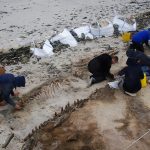

Amazing finds at Cata Sand

The excavation at Cata Sand on Sanday has unearthed a few surprises in the last few days including the discovery of Early Neolithic Houses and the skeletons of around twelve whales from the nineteenth century.
Archaeologists have now concluded that the structural remains are those of an Early Neolithic house (around 3,400 to 3,100BC) with associated occupation deposits, hearth and stone walls.
The early Neolithic house is both interesting and unusual in having been built on a deep layer of sand, which rests on rounded beach stones.
As the site is located on sand there is also good bone preservation, which is quite rare in other early Neolithic Orcadian settlements.
This high degree of preservation will allow the archaeologists to obtain a unique level of information regarding daily life within the early Neolithic house.
However, excavating this site has its challenges, not least that it is in the intertidal zone and is partly underwater twice a day!
Perhaps the most amazing and unexpected discovery has been to find two large cut pits within the trench that contain the skeletons of a minimum number of twelve whales.
Several people have recounted a tradition of whales being ca’d (driven) ashore at Cata Sands. This tradition could account for the whale remains.